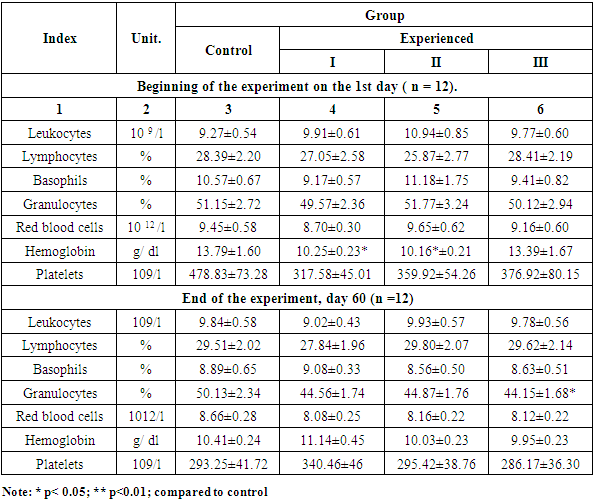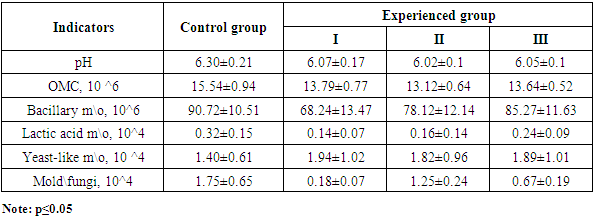-
Paper Information
- Paper Submission
-
Journal Information
- About This Journal
- Editorial Board
- Current Issue
- Archive
- Author Guidelines
- Contact Us
International Journal of Virology and Molecular Biology
p-ISSN: 2163-2219 e-ISSN: 2163-2227
2024; 13(4): 49-53
doi:10.5923/j.ijvmb.20241304.01
Received: Jul. 3, 2024; Accepted: Jul. 23, 2024; Published: Jul. 27, 2024

Evaluation of Biostimulants for Correction of Immune System Disorders in Cows and Influence for Improving the Composition of Milk Quality
Kaxorov Bolta Abdugaforovich, Rasulova Sevara Latipovna, Jumakulova Go‘zal Saifiddin Qizi, Shavkatova Khumora Ravshan Qizi, Khoshimov Abror Khamidjon O‘g‘li, Kataeva Yulduzkhon Albertovna
National University of Uzbekistan named after M. Ulugbek
Correspondence to: Kaxorov Bolta Abdugaforovich, National University of Uzbekistan named after M. Ulugbek.
| Email: |  |
Copyright © 2024 The Author(s). Published by Scientific & Academic Publishing.
This work is licensed under the Creative Commons Attribution International License (CC BY).
http://creativecommons.org/licenses/by/4.0/

To create an optimal ruminal environment for the vital activity of microorganisms and the digestion of food substrates of the diet when fed to ruminants, feed additives with various biological properties, such as biostimulants, modifiers, antioxidants, enzymes and phytobiotics, were used. The study conducted by the authors was to study the effect of biostimulants on milk production and the state of the immune system of cattle. The nutritional quality of ruminant animals must be improved and optimized in terms of the number of degradable and non-degradable parts. Based on the above, one of the ways to solve this problem on farms is to study the targeted effect of probiotic preparations on the intestinal microflora of ruminant animals. The prevention of metabolic diseases in animals is facilitated by the rational use of dietary nutrients. The results of the study conducted by the authors showed that the introduction of biostimulants into the body of animals changes milk production. And, importantly, the biologically active substances in milk correspond to the physiological norm. Livestock intensification and application industrial technologies significantly increase the load on the body cow and contributes to the tension of its functionality. It is known that changing technological conditions of detention do not always correspond to the physiological needs of animals, and in this situations, diseases arise that are based on metabolic disorders.
Keywords: Feed additives, Correction, Immunostimulants, Biostimulants, Milk, Cattle breeding, Leukocytes
Cite this paper: Kaxorov Bolta Abdugaforovich, Rasulova Sevara Latipovna, Jumakulova Go‘zal Saifiddin Qizi, Shavkatova Khumora Ravshan Qizi, Khoshimov Abror Khamidjon O‘g‘li, Kataeva Yulduzkhon Albertovna, Evaluation of Biostimulants for Correction of Immune System Disorders in Cows and Influence for Improving the Composition of Milk Quality, International Journal of Virology and Molecular Biology, Vol. 13 No. 4, 2024, pp. 49-53. doi: 10.5923/j.ijvmb.20241304.01.
Article Outline
1. Relevance
- Currently, one of the main objectives of the state policy of Uzbekistan in the field of nutrition of the population is the production and sale of products that are not only of high nutritional and biological value, but most importantly, safe for human life and health. Today, manufacturers are actively introducing technology for the production of biostimulants, which can be used both in the form of a solution and in the form of a dry additive to feed; it provides a high economic effect as it helps to increase the digestibility of feed [3,7]. The use of a biostimulant increases additional weight gain in animals, also helps reduce morbidity and increases the resistance of young animals. For the normal development of animals, easily digestible feed and biologically active additives are necessary, which have a positive effect on the digestive tract, stimulate metabolic processes and the development of internal organs, providing the growing body with biologically available substances. [11,14]. Cattle breeding is one of the strategically important branches of agriculture. Milk obtained from a cow is processed into dairy products, such as butter - a source of energy and fat-soluble vitamins, kefir - a source of beneficial lactobacteria and easily digestible milk protein, cheese - a source of protein, calcium, etc. In order to satisfy the population's needs for dairy products and not depend on imports, it is necessary to increase the milk productivity of cows. The main role in this matter is given to proper feeding. The domestic feed supply has a sufficient range of feed for the needs of dairy cattle breeding, but with modern high demands on animals and the high degree of influence of stress factors on their body, it is impossible to do without the use of feed additives. The positive properties of feed additives are widely known [1]. Various mineral, vitamin, protein supplements, biostimulants, etc. have been productively used in animal husbandry for many years. Particularly valuable in this regard are feed additives with biologically active properties (vitamin, mineral, natural compounds, such as humic acids, etc.), which not only replenish the animal diet for missing nutrients, but also serve as activators of metabolic processes, providing comprehensive has a positive effect on the entire body [1,2]. It is known that both the intensification of cattle breeding and the use of industrial technologies significantly increase the load on the cow’s body and contribute to the strain of its functionality. Changing technological conditions of detention do not always correspond to the physiological needs of animals, and in this situation, diseases associated with disruption of metabolic processes arise [3]. Among the complex of external conditions that affect the physical and chemical parameters of milk and their biological value, special attention should be paid to feeding dairy cattle. In addition, feed not only directly affects the productivity and quality of milk, but also indirectly affects the immune system [4]. In maintaining the efficiency of dairy cattle breeding, two main strategic directions can be distinguished: ensuring the health and high productivity of cows, direct milk producers, and raising strong, high-quality young animals for reparation and replenishment of the herd.In this study, the authors consider the issue of using feed additives based on humic acids for growing replacement young cattle and biostimulants in the diets of highly productive dairy cows.In recent years, in livestock farming, much attention has been paid to the development of various additives that can increase milk productivity, milk fat content, increase feed digestibility and stimulate metabolic processes. And these additives are mineral and probiotic feed additives [5]. In practice, feed additives with various biological properties are used, such as biostimulants, modifiers, antioxidants, enzymes, phytobiotics, when fed to ruminants, an optimal rumen environment is created for microbial activity and digestion of food substrates of the diet [6]. Taking into account the above, an urgent problem is the creation and introduction into production of biostimulants intended for inclusion in mixed feeds and diets that have a beneficial effect on metabolism, animal productivity, the quality and safety of products of animal origin [7].Today, modern approaches have been introduced into the normalized nutrition system for ruminant animals, in which the quality of nutrition should be optimized in accordance with the number of degradable and non-degradable parts [8]. In this regard, one of the directions for solving this problem is the targeted effect of probiotic drugs on the microflora of the stomach of animals [9].The mineral feed regulator and the probiotic additive “Profort” help create anaerobic conditions in the rumen, prevent metabolic disorders in animals, create prerequisites for the most complete disclosure of genetic productivity potential by animals, rational use of diet feed, and improve the quality characteristics of milk obtained from animals [10]. However, there is little information in the literature available to us about the use of mineral feed regulators and biostimulants in feeding dairy cows.Due to the insufficiency of protein and mineral nutrition of animals in agriculture, the need arose to create new feed additives that would combine the role of protein biostimulants and microelements. Taking this into account, there is a need to develop new drugs and feed additives of complex action in order to improve metabolic processes and safety, as well as determine the range of effectiveness of their use.
2. Purpose and Objectives of the Research
- The main goal of the study conducted by the authors was to study the effect of biostimulants on milk production and the state of the immune system in cattle.To achieve the goal, the following tasks were set:1. Determine the influence of feed tissue biostimulant on the milk productivity of cows and the quality of raw milk.2. Study the biochemical parameters of the blood of cows when using a tissue biostimulator.3. Assess the economic efficiency of introducing biostimulants into the diets of highly productive cows.
3. Research Methods
- Research was carried out using clinical-physiological, microbiological, veterinary-sanitary, zootechnical and mathematical methods. The effect of biostimulants in different doses on metabolic processes, productivity and quality of milk of cows was studied [12].The research was carried out on 32 dairy cows in the Zangiota district of the Tashkent region in 2021. Animals in the control and experimental groups received a diet consisting of wheat straw (0.6 kg), corn silage (23.0 kg), wheat haylage (50.0 kg), complete feed (14.58 kg), antigen (0.05 kg) and alfalfa haylage (6.50 kg). The animals of the experimental groups received a mineral feed regulator in a dose of 300 g daily in addition to the main diet (BR) as part of a complete feed.
4. Results and Discussion
- In accordance with the accepted scheme for zootechnical analysis of feed, dry matter (DM) of feed is the carrier of the nutritional value of feed. The higher the dry matter content of the feed, the higher its nutritional value. It is known that the DM consumption of bulky feeds depends on the concentration of metabolic energy in them and the level of productivity. Biostimulants were administered to animals for 30 days, 10 ml. intramuscularly. As a result, dairy cows received an increase of 2 liters of milk every ten days, which in composition and fat content became 1.5 times higher than the control group. The animals were divided into 3 groups of 10 animals. I – group is a regular corva. II – control group. Group III received tissue biostimulants. As a result, the data obtained shows that the tissue biostimulator increases the amount of milk and affects the quality of milk.Hematological blood parameters of experimental cows are presented in Table 1. During the entire period of the experiment, the concentration of leukocytes in the control and experimental groups was within physiological norms and had an average value of 9.5 109/l in the control group and 9.9 109/l in the experimental groups groups. The content of lymphocytes at the beginning and at the end of the experiment in the control and experimental groups was within physiological norms and no significant changes were observed. Control group - average content for the entire period - 33.9%. Experienced groups: I – 27.4%; II –27.8%; III – 29.01%.
|
|
5. Conclusions
- According to the task, further research conducted by the authors was aimed at studying the effect of tissue biostimulants on productivity and metabolism in dairy cows. It is known that feeding, and as a consequence, the introduction of tissue biostimulants, is one of the leading factors in ensuring high productivity of dairy livestock. This is explained by the fact that during lactation the animal’s body is in a state of increased functional activity; complex processes of fermentation of feed through a huge number of bacteria, fungi, protozoa, as well as the absorption of nutrients and the synthesis of new ones, take place in the forestomach. As a result, the data obtained shows that the tissue biostimulator increases the amount of milk and affects the quality of milk.All this provides the animal with the necessary energy and nutrients, affects the physiological processes occurring in the body, which in turn helps to enhance metabolic processes, productive and reproductive phenomena. An important point in these processes is the ability to control rumen digestion by adjusting the diet through the use of various biostimulants.
 Abstract
Abstract Reference
Reference Full-Text PDF
Full-Text PDF Full-text HTML
Full-text HTML
